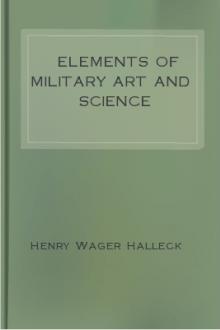Elements of Military Art and Science by Henry Wager Halleck (books you have to read txt) 📕

- Author: Henry Wager Halleck
- Performer: -
Book online «Elements of Military Art and Science by Henry Wager Halleck (books you have to read txt) 📕». Author Henry Wager Halleck
"The value of the small works on the cape and bluffs, was clearly defined in these results; being above the dense cloud of smoke that enveloped the ships and the lower forts, their aim was not embarrassed, while the seamen labored under the difficulty of firing, with an inconvenient elevation, at objects that they saw but seldom, and then but dimly and briefly. As a consequence, three line-of-battle ships and a frigate were driven off very shortly and in great peril, and a fourth badly cut up; while the Agamemnon lay opposed to one of the heaviest sea-forts with two tiers of casemates, and at the end of five-hours came off with comparatively little loss."
"Whatever superiority of effect the batteries on the heights may have had (and we have so few details about these works that we can draw no sure conclusion from this mere naked statement of damages received by the vessels), it evidently was not for want of being hit often enough (smoke or no smoke), that the Agamemnon escaped with so little injury. She 'was struck by 240 shot and shells;' and it is only due to the inefficiency of the projectiles by which she was struck, that she was not destroyed."
"With respect to the damages received by Fort Constantine, Dahlgren says:—"
"' The distance of the Agamemnon and Sanspareil from Fort Constantine (17th October, 1854), was assumed to be about 800 yards; Lord Raglan states it to have been rather less. These two ships could bring to bear about 87 guns, and the firing from them probably lasted some four hours. There can be no doubt that it inflicted much damage, for the Russian Commander-in-chief-admits it in his official report; but not sufficient to impair the strength of the masonry, and far short of effecting a breach in it."
"'At Bomarsund, the results were rather different:—Three 32-pounders of 42 cwt. (guns of inferior weight), were landed from a ship's spar deck, and placed in battery at 950 yards from the North Tower—the masonry of good quality and 6-1/2 feet thick. In eight hours, the wall between two embrasures was cut through from top to bottom, offering a practicable breach, to effect which 487 shot and 45 shells were fired, being at the rate of one round from the battery in rather less than a minute; or, from each gun, one in 2-3/4 minutes. The Tower surrendered."
"'It seems almost incredible that three pieces should be able to accomplish fully that which eighty-seven pieces utterly failed to do, the distances from the object being alike—particularly when it is considered that many of the latter were of greater calibre, and most of them employed much heavier charges where the calibres were similar. The guns of the ship, if fired at the same rate as those of the battery, which was not unusually rapid (one round in two and three-fourth minutes), would have discharged some seven thousand seven hundred shot and shells in the course of the four hours, supposing no interruption; a number which, if properly applied, would appear, from the results of three guns, to have been sufficient to breach the wall of the fort in fourteen places; whereas they did not effect a single breach, which is abundant proof of the lack of accuracy. They must either have been dispersed over the surface of the fort, or else missed it altogether, and this could have been due only to a want of the precision which was attained by the battery. The constantly preferred complaint of motion in the ships was not to be urged, because on the day of cannonading Sebastopol, there was scarcely a breath of wind, and the ships were too large to be easily moved by the swell, unless very considerable. That the fort did no greater damage to the ships than it received from them, proves no more than that its fire was quite as illy directed, and the calibres too low. It is said that the Agamemnon was struck in the hull by two hundred and forty shot and shells, which must have been but a small portion of what was fired, though sufficient to be decisive, if, as already observed, the calibre had been heavier.'"
Here, then, a number of projectiles thrown from the ships, which were sufficient, had they been thrown from a land battery, according to the result at Bomarsund, to produce fourteen practicable breaches, failed not only to produce a single breach, but even "to impair the strength of the masonry."
The reason of this is obvious. That degree of precision of fire by which a breach is effected by a land battery is utterly unattainable from a floating structure, for the motion of the water, even in the calmest days, is quite sufficient to prevent accuracy of aim at an object at a distance, as in this case, of seven and eight hundred yards.
With respect to the action of the shot and shells upon the Agamemnon, it is to be remarked that we have as yet had no fair trial of the power of the fire of modern shell-guns of large calibre from land batteries against ships of war. The Russians had some of them in their fleet, and at Sinope, with their shell-guns, they blew up two Turkish frigates in fifteen minutes. It does not appear that in the Crimean war they had yet provided their fortifications with the modern armaments, for where shells were thrown from their sea-coast batteries, they were in every instance of inferior calibre.
With respect to the naval attack upon Kinburn, which has been referred to as showing the importance of floating batteries as an auxiliary to ships in reducing harbor defences, we have no official reports of the Russians from which to derive accurate information of the strength of the works attacked. Dahlgren, drawing his information from the official accounts of the "English and French admirals," describes the works and their location is follows:—
"The Boug and the Dnieper issue into a large basin, formed partly by the projection of the main shore, partly by a long narrow strip of Sand-beach, which continues from it and takes a north-westerly direction until it passes the promontory of Otchakov, where it terminates, and from which it is separated by the channel, whereby the waters of the estuary empty into the Black Sea."
"The distance between the spit or extremity of this tongue and the Point of Otchakov, or the main shore opposite, is about two miles; but the water is too shoal to admit of the passage of large vessels of war, except in the narrow channel that runs nearest to the spit and its northern shore. Here, therefore, are placed the works designed to command the entrance. They are three in number. Near the extreme point of the spit is a covered battery built of logs, which are filled in and overlaid with sand,—pierced for eighteen guns, but mounting only ten."
"Advancing further along the beach is a circular redoubt, connected with the spit battery by a covered way. This work, built of stone, and riveted with turf, is open, and said to be the most substantial of the three; it has eleven cannon, and within is a furnace for heating shot."
"Further on, and where the beach has widened considerably, is Fort Kinburn, a square bastioned work, extending to the sea on the south, and to the waters of the estuary on the north. It is casemated in part, though but few of these embrasures were armed,—its chief force being in the pieces en barbette, and some nine or ten mortars. The masonry, though solid, is represented by an eye-witness not to be bomb-proof, and so dilapidated by age that the mortar was falling out from the interstices, leaving the stone to disintegrate. The interior space was occupied by ranges of wooden buildings, slightly constructed and plastered over."
"This fort is said to be armed with sixty pieces. The English admiral states, that all three of the works mounted eighty-one guns and mortars. The calibres are not given officially, but stated in private letters to be 18-pounders and 32-pounders.'"
"The above description will quite justify the further remark as to these works:—"
"They were inferior in every respect, and manifestly incapable of withstanding any serious operation by sea or land. The main fort was particularly weak in design, and dilapidated; all of them were indifferently armed and garrisoned.'"
"So much for the works. As to the character of the armament brought to the assault, the same authority says:—
"The allied force was admirably adapted to the operation, embracing every description of vessel, from the largest to the smallest, and all propelled by steam. There were screw-liners, and like vessels of inferior class, side-wheel steamers, screw gunboats, floating-batteries, mortar-vessels, etc., each armed in what was considered the most approved manner. And this truly formidable naval force carried besides some thousand troops' on board, all designed to attack these dilapidated' works of Kinburn."
"Without going into the particulars, we simply give Dahlgren's account of the affair:—"
"The French floating-batteries (Devastation, Lave, and Tonnante) steamed in to make their first essay, anchoring some six or seven hundred yards off the S.E. bastion of Fort Kinburn, and at 9.20 opened fire, supported by the mortar-vessels, of which six were English, by the gunboats, five French and six English, and by the steamer Odin, 16."
"The heavy metal of the floating-batteries (said to be twelve 50-pounders on the broadside of each) soon told on the walls of the fort; and the vertical fire was so good that the French admiral attributed to it, in great part, the speedy surrender of the place. The gunboats also made good ricochet practice, which was noticed to be severe on the barbette batteries."
"The Russian gunners, in nowise daunted by this varied fire, plied their guns rapidly in return, directing their attention chiefly to the floating-batteries, which were nearest."
"Exactly at noon, the admirals steamed in with the Royal Albert 121, Algiers, 91, Agamemnon, 90, and Princess Royal, 90, with the four French liners in close order, taking position in line, ranging N.W. and S.E., about one mile from the fort, in twenty-eight feet water."
"At the same time, a squadron of steam-frigates, under Rear-Admirals Stewart and Pellion, dashed in through the passage to the basin, opening fire on the spit and central batteries in passing, and anchoring well inside of Fort Nicholaiev and Otchakov. The attack seaward was completed by the Acre, 100, Curaçoa, 30, Tribune, 30, and Sphynx, 6, opening on the central battery; while the Hannibal, 91, Dauntless, 24, and Terrible, 21, assailed that on the spit. To this storm of shot and shells, the Russians could not reply long. In the spit battery, the sand falling through between the logs, displaced by shot and shells, choked the embrasures, and blocked up the guns. In the fort, the light wooden buildings were in flames at an early hour; then the walls began to crumble before the balls which came from every quarter, front, flank, and rear; and as the guns were disabled successively, the return became feeble, until few were in condition to be fired, the central redoubt alone discharging single guns at long intervals. The Russian commander, however, made no sign of surrender; but the admirals, seeing that his fire had ceased, and further defence was unavailing, hoisted the white flag at 1.35 P.M., upon which the works were given up on honorable terms."
"The garrison consisted of about fourteen hundred men; their loss is differently stated,—the French admiral says eighty wounded,—another, forty-three killed and one hundred and fourteen





Comments (0)